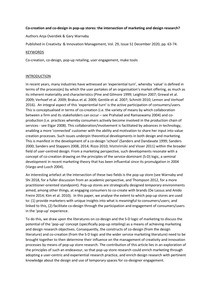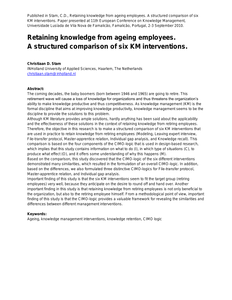accepted abstract Quis14 conference Field findings show that value dimensions in legal services are functional, social and emotional. The last category emerges not only within but also outside the interaction with the lawyer. Recommendation of others or the trackrecord of lawyers for example, which play a role before or after the service, contribute to emotional values like trust and reassurance and help clients to reduce the perceived purchase risk, which is inherent to the nature of credence services. Also due to the credential character of legal services we conclude that not only professional skills but also service aspects as client involvement play an important role in the emergence of value because professional skills are difficult to judge even by routine buyers.
DOCUMENT
More than 25!years after Moore’s first introduction of the public value concept in 995, the concept is now widely used, but its operationalization is still considered difficult. This paper presents the empirical results of a study analyzing the application of the public value concept in Higher Education Institutions, thereby focusing on how to account for public value. The paper shows how Dutch universities of applied sciences operationalize the concept ‘public value’, and how they report on the outcome achievements. The official strategy plans and annual reports for FY2016 through FY2018 of the ten largest institutions were used. While we find that all the institutions selected aim to deliver public value, they still use performance indicators that have a more narrow orientation, and are primarily focused on processes, outputs, and service delivery quality. However, we also observe that they use narratives to show the public value they created. In this way this paper contributes to the literature on public value accounting.
DOCUMENT

This article analyzes how a city can generate instrumental, intrinsic, and institutional value from its event-related networks and platforms, based on the Hieronymus Bosch 500 program in the Dutch city of ‘s-Hertogenbosch (Den Bosch). Interviews with key stakeholders traced program dynamics over more than a decade to reveal processes of network and platform development, encapsulated in a conceptual model of strategic value creation. The results indicate that networks served to generate flows of resources, while programming helped develop platforms for knowledge generation and dissemination, helping to focus attention on the city. The Bosch 500 Foundation managing the program played an effective role in developing and supporting networks, which in turn generated significant short-term instrumental and intrinsic value. However, the failure to establish a sustainable city-wide platform related to the Bosch program caused institutional value destruction, which many saw as a missed opportunity. The study of networks and platforms can benefit from a longitudinal approach as well as a broader, contextual view of event networks.
MULTIFILE
Innovation in the 21st century has been moving continuously away from the model embraced in the last century, which was characterized as a profit-oriented and silo-targeted one. Currently, the logic is being driven towards “the social” sense and value of the transformation within the reality of complexity and the continuous necessity of designing and re-designing concepts towards sustainability of a different level. The underlying motive of innovation has been for long perceived as generating predominantly economic value. However, co-designing the society in the future is now being transformed into tackling social challenges in a multi-layered complexity scenario. Thus, there has been identified a need to find complementary ways to nurture innovation, generating social and public value based on interdependence and the emergence of interrelated and constantly networking actors.
MULTIFILE

In BOP ventures the notion of “selling to the poor” has steadily been replaced by business approaches that suggest sustainable value creation. This has certain implications, in particular the development of strategies that serve triple bottom-line goals. These include economic, social and environmental benefits, in other words, the well known goals of people-planet-profit. However to optimise value-creation one ideally needs to follow a strategy that is based on some form of conceptual model that can serve as a frame of reference. This paper proposes such a conceptual model. The research was undertaken in 8 BOP projects involving multinational information and communication technology companies in Africa. ICT is relevant here because of frequently high expectations that it contributes positively to development goals. A study of the BOP literature reveals that several elements need consideration when trying to create value in developing areas. In addition it emerges that these elements are somehow interdependent. Using information found in the literature as guide a study of 8 cases was undertaken. The research approach was the case study method and the data was analysed for emerging patterns. Primary and secondary data was collected through interviews as well as a close study of archival and other sources. The analysis revealed three high level factors that may need to be aligned in order to ensure optimised value creation of BOP ventures. These three factors are BOP strategy, partnerships, and products & services development. It is also confirmed that neither BOP strategy nor partnerships nor products/service development can be synthesised independently from the rest. There is a delicate balance and interaction between the three where all three are interdependent and mutually influence each other.
DOCUMENT

Co-creation as a concept and process has been prominent in both marketing and design research over the past ten years. Referring respectively to the active collaboration of firms with their stakeholders in value creation, or to the participation of design users in the design research process, there has arguably been little common discourse between these academic disciplines. This article seeks to redress this deficiency by connecting marketing and design research together—and particularly the concepts of co-creation and co-design—to advance theory and broaden the scope of applied research into the topic. It does this by elaborating the notion of the pop-up store as temporary place of consumer/user engagement, to build common ground for theory and experimentation in terms of allowing marketers insight into what is meaningful to consumers and in terms of facilitating co-design. The article describes two case studies, which outline how this can occur and concludes by proposing principles and an agenda for future marketing/design pop-up research. This is the peer reviewed version of the following article: Overdiek A. & Warnaby G. (2020), "Co-creation and co-design in pop-up stores: the intersection of marketing and design research?", Creativity & Innovation Management, Vol. 29, Issue S1, pp. 63-74, which has been published in final form at https://doi.org/10.1111/caim.12373. This article may be used for non-commercial purposes in accordance with Wiley Terms and Conditions for Use of Self-Archived Versions. LinkedIn: https://nl.linkedin.com/in/overdiek12345
MULTIFILE

Immersive technologies are redefining and revolutionizing the staging of experiences and co-creation of value, implicating the management of customer experiences. However, limited studies have looked at the role of immersive technologies as part of the customer experience management (CXM) process. Incorporating the concepts of experience economy and value co-creation, this study proposes a dynamic CXM framework that highlights the emerging field of immersive technologies like augmented and virtual reality as part of business and marketing research. The framework acts as a guide for researchers and industry practitioners to initiate immersive technology ventures that are rooted in the co-creation and management of customer experiences
MULTIFILE
A transition from a linear economy to a more sustainable and circular economy requires different business models. In this chapter, we provide you with an introduction to the nature and logic of business models. In essence, a business model is a description of how value creation between parties or partners is organized, at a particular moment, in a specific context, and given available resources. Conventional business modelling approaches have several weaknesses---the main point of criticism being their focus on creating financial value. With the Business Model Template (BMT), we try to resolve most of these criticisms. To do so we introduce three archetypal business models: the platform, community, and circular economy business models. This chapter provides an overview on how, over three stages and ten building blocks that together make up the Business Model Template, these archetypal business models will be used.
LINK
The coming decades, the baby boomers (born between 1946 and 1965) are going to retire. This retirement wave will cause a loss of knowledge for organizations and thus threatens the organization‟s ability to make knowledge productive and thus competitiveness. As knowledge management (KM) is the formal discipline that aims at improving knowledge productivity, knowledge management seems to be the discipline to provide the solutions to this problem. Although KM literature provides ample solutions, hardly anything has been said about the applicability and the effectiveness of these solutions in the context of retaining knowledge from retiring employees. Therefore, the objective in this research is to make a structured comparison of six KM interventions that are used in practice to retain knowledge from retiring employees (Modeling, Leaving expert interview, File-transfer protocol, Master-apprentice relation, Individual gap analysis, and Knowledge recall). This comparison is based on the four components of the CIMO-logic that is used in design-based research, which implies that this study contains information on what to do (I), in which type of situations (C), to produce what effect (O), and it offers some understanding of why this happens (M). Based on the comparison, this study discovered that the CIMO-logic of the six different interventions demonstrated many similarities, which resulted in the formulation of an overall CIMO-logic. In addition, based on the differences, we also formulated three distinctive CIMO-logics for File-transfer protocol, Master-apprentice relation, and Individual gap analysis. Important finding of this study is that the six KM interventions seem to fit the target group (retiring employees) very well, because they anticipate on the desire to round off and hand over. Another important finding in this study is that retaining knowledge from retiring employees is not only beneficial to the organization, but also to the retiring employee himself. From a methodological point of view, important finding of this study is that the CIMO-logic provides a valuable framework for revealing the similarities and differences between different management interventions.
DOCUMENT

In today’s intellectual capital literature, we see a shift from identifying intangibles towards understanding the dynamics of value creation. As it is not clear what “dynamic” stands for, the aim of this explorative and conceptual paper is to contribute to a better understanding of the dynamic dimension of IC. Based on a review of the early IC literature, the dynamic dimension (or dynamics) of intellectual capital seems to refer to the logic that value creation is the product of interaction between different types of (intangible) resources. As the idea of value creation through combination of knowledge resources is closely related to the New Growth Theory (Romer, 1990, 1994), this paper explores the New Growth Theory and its implications for the dynamic dimension of intellectual capital. Based on the exploration of the New Growth Theory, a conceptual model is presented in which the elements that constitute the dynamic dimension of intellectual capital are integrated. These elements are ideas, things, the process of knowledge creation, the process of continuous innovation, and institutions. The main conclusion of this paper is that the concept of knowledge is more closely related to the dynamic dimension of IC, than the concept of intellectual capital. Therefore, further research would probably benefit from approaching this topic from a knowledge management point of view. It is suggested that further research should focus on exploring the metaphors that contribute to a better understanding of the dynamics of IC, on the contribution that ideas can make to increase the effectiveness of knowledge management, and finally on the institutional arrangements that support the process of knowledge creation and innovation.
DOCUMENT